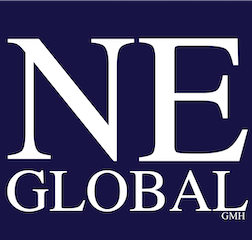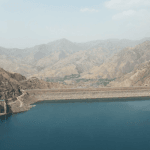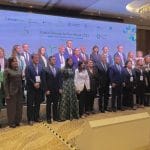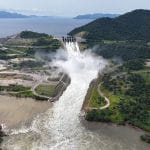On December 29, Danish transmission system operator (TSO) Energinet launched the Viking Link, the world’s longest electricity interconnector, establishing a subsea cable connection across the North Sea between the UK and Denmark.
Viking Link is a 765-km long, 1400 MW high voltage direct current (DC) electricity link between the British and Danish transmission systems connecting at Bicker Fen substation in Lincolnshire and Revsing substation in southern Jutland, Denmark. The project involves the construction of converter sites and installation of onshore and offshore cable in each country. These are then connected to the substations, allowing electricity to be exchanged between Great Britain and Denmark.
Energinet put the Viking Link into operation on December 29 with an 800 MW import and export capacity of the new electricity connection between Denmark and England. The full capacity of 1,400 MW reportedly cannot be offered to the electricity market from the start, as the West Jutland high-voltage grid has not yet been developed sufficiently and could threaten the power supply in the whole of Western Denmark.

After the invasion of Ukraine, interconnectors became much more crucial to the energy supply in Europe.
“Investments in interconnectivity, especially in gas and electricity, is a quintessential driver of European diversification away from Russian gas imports,” Francesco Sassi, research fellow in energy geopolitics and markets at RIE, told NE Global on December 28, citing as an example Denmark, which has been abruptly cut off from Russian gas in mid-2022 and domestic renewable energy, especially wind, has grown even more as an alternative to expensive gas and liquified natural gas (LNG) imports.
“On this point, the Viking Link is not a direct consequence of Europe’s diversification strategy as the project was approved well before the Russian invasion of Ukraine. Yet, this is the context where it will start operating,” he said.
According to Energinet and National Grid, the Viking Link interconnector will enable the more effective use of renewable energy, access to sustainable electricity generation and improved security of electricity supplies. It will benefit the socio economy of both countries.
Sassi noted that even if this is a positive timing to connect two wind-rich energy markets such as the UK and Denmark, the same infrastructure will face capacity curtailment due to insufficient grid investments in Denmark. At the same time, the European wind industry is closing probably what will end up as its worst year in history, he added.
“All these points show how hard and costly it is, even for rich Northern European economies, to accelerate the energy transition in times of supply chain disruptions, tight monetary policies, geopolitical fragmentation and polarization between energy security and energy transition policies and strategies,” Sassi said.

The Viking Link would make the UK and Denmark more interdependent. To meet international and domestic renewable and climate change targets, the UK and Denmark will generate more power from renewable sources, including offshore wind.
According to Energinet and National Grid, the UK faces a major challenge in how it continues to meet the country’s increasing energy needs and addresses the problem of climate change. By linking with other countries’ transmission systems, National Grid can increase the diversity and security of energy supplies, facilitate competition in the European market and help the transition to a low carbon energy sector by integrating renewable sources.
In its first year, Viking Link is expected to save more than 600,000 tonnes of carbon emissions – this is equivalent to taking 280,000 cars off the road.
Viking Link will also help the UK Government meet its carbon reduction commitments by providing access to a well-developed, low cost renewable energy market. At full capacity Viking Link will allow the sharing of enough clean electricity to power up to 2.5 million UK homes.
Denmark is aiming for 100 percent renewable energy in their electricity systems by 2030.

The capacity to balance wind production and demand across countries and closer integration between electricity systems will be vital for the efficient transition towards a green energy future.
According to Energinet and National Grid, wind generation outputs between the UK and Denmark show low correlation and periods of high production are unlikely to occur at the same time in both countries. Energy that is surplus to requirements will be easily transmitted through the interconnector to where the level of demand is higher. This will support the renewable energy markets in both countries, reduce the need to curtail generation during peaks in production and have a beneficial impact on market prices.
The link will bring huge benefits for UK consumers with savings of over £500 million in the first 10 years, by importing cheaper energy, National Grid said.
Principal contractor Siemens Energy built the converter station in the UK, while Energinet built the Danish converter station. The HVDC offshore cable was manufactured and laid by Prysmian Group. The cable was laid on the seabed using a custom-made vessel Leonardo Da Vinci which was then buried using Asso’s trenching fleet.
Prysmian Group manufactured the HVDC land cable which was installed by Balfour Beatty, the offshore section was manufactured and installed by Prysmian Group in the UK and the Danish land section was manufactured by NKT and installed by Monck.








